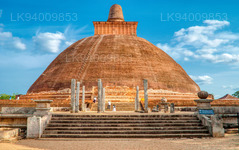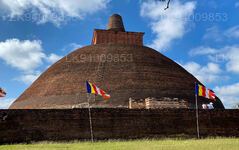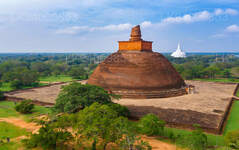
Anuradhapura City
Anuradhapura is belongs to the North Central Province in to Sri Lanka. Anuradhapura is one of the ancient capitals of Sri Lanka, famous for its well-preserved ruins of ancient Lankan civilization. The city, now a UNESCO World Heritage Site, lies 205 km north of the current capital Colombo in Sri Lanka.
Jetavanaramaya (ජේතවනාරාමය)
Der Jetavanarama- Stupa oder Jetavanaramaya ist ein Stupa oder buddhistisches Reliquienmonument in den Ruinen des Klosters Jetavana in der UNESCO-Weltkulturerbestadt Anuradhapura in Sri Lanka . Mit 122 Metern (400 Fuß) war er der höchste Stupa der Welt und das dritthöchste Bauwerk der Welt, als er von König Mahasena von Anuradhapura (273–301) erbaut wurde. Er begann mit dem Bau des Stupa 49 Jahre nach der Zerstörung des Mahaviharaya von Anuradhapura . Sein Sohn Maghavanna I. vollendete den Bau des Stupa, der von Parakramabahu I. von Polonnaruwa renoviert wurde. Ein Teil einer Schärpe oder eines Gürtels, der vom Buddha gebunden wurde, gilt als die Reliquie, die hier aufbewahrt wird.
Das Bauwerk ist in der Geschichte der Insel von Bedeutung, da es die Spannungen innerhalb der buddhistischen Sekten Theravada und Mahayana darstellt. In der aufgezeichneten Geschichte ist es auch als eines der höchsten Bauwerke der antiken Welt und als höchstes nicht-pyramidenförmiges Gebäude von Bedeutung. Die Höhe des Stupa betrug 122 Meter (400 Fuß), was ihn zum höchsten Stupa der antiken Welt machte. Mit der Zerstörung und Aufgabe des Königreichs Anuradhapura im 11. Jahrhundert wurde der Stupa zusammen mit anderen vom Dschungel bedeckt. König Parakramabahu versuchte im 12. Jahrhundert, diesen Stupa zu renovieren, und er wurde auf die heutige Höhe wiederaufgebaut, eine Verkleinerung gegenüber der ursprünglichen Höhe. Heute ist er 71 Meter (233 Fuß) hoch.
Das Gelände erstreckt sich über etwa 5,6 Hektar und beherbergte schätzungsweise 10.000 buddhistische Mönche. Eine Seite der Stupa ist 176 m lang, und die Treppen an jeder der vier Seiten sind 9 m breit. Der Türpfosten zum Schrein im Hof ist 8 m hoch. Die Stupa hat ein 8,5 m tiefes Fundament und steht auf Felsgestein.
Das Bauwerk ist zwar nicht mehr das höchste, aber mit einer Grundfläche von 233.000 m² immer noch das größte. Für den Bau wurden rund 93,3 Millionen gebrannte Ziegel verwendet. Die Ingenieurskunst, die hinter dem Bau des Bauwerks steckt, stellt eine bedeutende Entwicklung in der Geschichte der Insel dar.
About Anuradhapura District
Anuradhapura is belongs to the North Central Province in to Sri Lanka. Anuradhapura is one of the ancient capitals of Sri Lanka, famous for its well-preserved ruins of ancient Lankan civilization. The city, now a UNESCO World Heritage Site, lies 205 km north of the current capital Colombo in Sri Lanka.
In the sacred city of Anuradhapura and in the vicinity are a large number of ruins. The ruins consist of three classes of buildings, dagobas, monastic buildings, and pokuna (ponds). The city had some of the most complex irrigation systems of the ancient world, situated in the dry zone of the country the administration built many tanks to irrigate the land. Most of the civilians are Sinhala, while Tamils and Sri Lankan Moors live in the district.
About North Central Province
North Central Province which is the largest province in the country covered 16% of total country's land area. North Central Province consist two districts called Polonnaruwa and Anuradhapure. Anuradhapura is the largest district in Sri Lanka. Its area is 7,128 km².
North Central Province has numerous potentials for Investors to start their Businesses, especially Agriculture, agro based industries and Livestock sectors. More than 65% of North Central Province's people depend on basic Agriculture and agro base industries. NCP also called "Wew Bendi Rajje" because there are more than 3,000 medium and large scale tanks situated in the province. Sri maha bodiya, Ruwanweli seya, Thuparama dageba, Abayagiri Monastry, Polonnaruwa Rankot wehera, Lankathilake are scared














